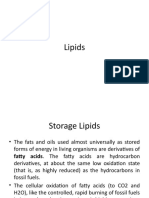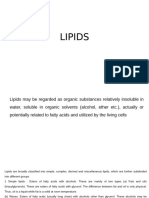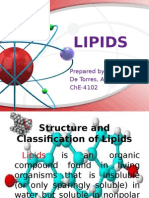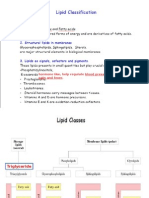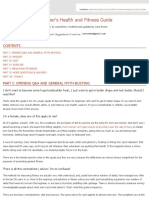1
Uploaded by
bipexe21601
Uploaded by
bipexe2160It plays a crucial role in the biological signaling pathway.
The precursor of
potent signaling mediators is lipid peroxidation.
The metabolism of fatty acids acts as a cellular fuel source.
Fatty acids store energy as fat droplets- composed of hydrophobic triacylglycerol
molecules within adipocytes (specialized fat cells that store and metabolize
lipids).
It helps to form a cell membrane, also called a plasma membrane, which encloses all
cells and the other related intracellular organelles. The cell membrane is composed
of a phospholipid bilayer ( lipid molecules) comprised of two fatty acid chains
bound to glycerol and a hydrophilic (head) phosphate group joined to a smaller
hydrophilic (tail) compound (e.g., choline).
It helps in protein modification: fatty acids interact with various proteins.
Types of Fatty Acids
There are three types of fatty acids:
Saturated fatty acids
Unsaturated fatty acids
Trans fats
Saturated Fatty Acids
Saturated fatty acids are saturated with hydrogen and contain 12–22 carbon atoms.
It is also known as bad or unhealthy fats because they are pernicious to our
health, such as increased risk of heart disease and stroke.
It remains solid at room temperature.
Saturated fatty acids have a higher melting point than unsaturated fatty acids.
Examples are lauric acid (CH3(CH2)10COOH), palmitic acid (CH3(CH2)14COOH), and
stearic acid (CH3(CH2)16COOH).
Saturated fats containing foods include cheese, butter, milk, Coconut, Palm and
palm kernel oils, Beef, Lamb, Pork, Skin of chicken and turkey, Lard, Full-fat
dairy, Ice cream, Cream, and Some baked and fried foods.
Trans Fatty Acids
There are two sources of trans fatty acids: natural and artificial (liquid oils).
In industrial processes, artificial trans fats are converted into solids.
Trans fatty acids are bad/ artificial fatty acids present in all processed foods.
The primary dietary source is partially hydrogenated oils.
It can cause the risk of heart disease, stroke, and type-2 diabetes.
Unsaturated Fatty Acids
Unsaturated fatty acids are fatty acids that have one or more double bonds between
carbons, such as alkenes.
It tends to be liquid at room temperature.
They are good or healthy fats because they are innocuous to our health.
Examples are Oleic (CH3(CH2)7CH=CH(CH2)7COOH), Linoleic
(CH3(CH2)4(CH=CHCH2)2(CH2)6COOH), Linolenic (CH3CH2(CH=CHCH2)3(CH2)6COOH), and
Arachidonic (CH3(CH2)4(CH=CHCH2)4(CH2)2COOH).
Unsaturated fat breaks down into two types:
Monounsaturated fatty acids
They are fatty acids containing one carbon-carbon double bond; most fatty acids are
present in positions between 16 and 22 carbons in length containing a cis double
bond.
The sources of monounsaturated fatty acids are Olive oil, Peanut oil, Canola oil,
Safflower oil, Sesame oil, Avocado, Peanut butter, and many nuts and seeds.
Polyunsaturated fatty acids (PUFAs)
Polyunsaturated fatty acids are fatty acids that comprise long chains of carbon
atoms with a carboxyl group at one end and a methyl group at the other.
These fatty acids contain more than one double bond produced by plants and
phytoplankton.
The two classes of polyunsaturated fatty acids (PUFAs) are: Omega-3 fatty acids
(Tuna, Salmon, Trout, Herring, Sardines, Flaxseeds and flaxseed oil, Walnuts, and
chia seeds ) and Omega-6 fatty acids (Safflower oil, Sunflower oil, Corn oil,
Soybean oil, Sunflower seeds, pumpkin seeds).
The carbon-carbon double bond located between the third and fourth carbon atoms
from the methyl end of the chain is called Omega-3 fatty acids (ω-3 fatty acids).
Omega-6 fatty acids (ω-6 fatty acids) are fatty acids in which the carbon-carbon
double bond is present between the sixth and seventh carbon atoms from the methyl
end of the chain. The Omega-6 fatty acid examples are Linoleic acid (C18:2n-6) and
arachidonic acid (C20:4n-6).
Omega-3 Fatty Acids (ω-3 Fatty Acids)
Omega-3 fatty acids, also known as n-3s, mean the carbon-carbon double bond is
present between the third and fourth end carbon atoms.
There are two ends in fatty acids: carboxylic acid (COOH) alpha end-initial of the
chain and methyl (CH3) omega end-tail of the chain.
C60H92O6 is the molecular formula of omega-3 fatty acids, and the molecular weight
is 909.39 g/mol.
Omega-3 fatty acids found in fish are long-chain, whereas Omega-3 fatty acids
present in plants are shorter chains. Long-chain omega-3 enters more rapidly in the
blood, and cells show fast effects. Short-chain omega-3 fatty acids convert into
long-chain fatty acids.
Examples are Linoleic acid, Gamma linoleic, Arachidonic Acid, Conjugated linoleic
acid, Alpha-linolenic acid, and Ocosahexaenoic acid.
In addition, Omega-3 supplements, such as Omega-3-acid ethyl esters, Boldfit
Flaxseed omega-3 Supplement, Boldfit omega-3 Fish Oil, Lovaza, Vascazen, Omtryg can
be ingested by those who do not eat omega-3-rich foods.
You might also like
- ESMO Handbook Nutrition and Cancer 2nd Edition100% (2)ESMO Handbook Nutrition and Cancer 2nd Edition164 pages
- Freedom Food 2.0 Cooked by Kate FlowersNo ratings yetFreedom Food 2.0 Cooked by Kate Flowers120 pages
- Student Assessment: SITHCCC0013 Prepare Seafood DishesNo ratings yetStudent Assessment: SITHCCC0013 Prepare Seafood Dishes42 pages
- Dr. Hewaida Fadel Dr. Tarek El Sewedy: Department of Medical Laboratory Technology Faculty of Allied Medical SciencesNo ratings yetDr. Hewaida Fadel Dr. Tarek El Sewedy: Department of Medical Laboratory Technology Faculty of Allied Medical Sciences45 pages
- Lipids in Human Nutrition: Prof. Chandrani LiyanageNo ratings yetLipids in Human Nutrition: Prof. Chandrani Liyanage21 pages
- Chapter Three The Process Technology of Oil and Fat Industries Fat and OilNo ratings yetChapter Three The Process Technology of Oil and Fat Industries Fat and Oil21 pages
- Preprint_Article_LundandRustan_22052020No ratings yetPreprint_Article_LundandRustan_2205202020 pages
- Chemistry of Lipids: Preethi S Department of BiochemistryNo ratings yetChemistry of Lipids: Preethi S Department of Biochemistry37 pages
- Lipids (Fats and Oils) : Laboratory Medicine Program Second YearNo ratings yetLipids (Fats and Oils) : Laboratory Medicine Program Second Year31 pages
- Lipids: Prepared By: de Torres, Angelica M. Che-4102No ratings yetLipids: Prepared By: de Torres, Angelica M. Che-410237 pages
- Lipids Basics: Fats, Oils, in Foods and Health: Socorro Milagros C. Alcancia, RND, PHDNo ratings yetLipids Basics: Fats, Oils, in Foods and Health: Socorro Milagros C. Alcancia, RND, PHD9 pages
- Kurdistan Regional Government: Ministry of Higher EducationNo ratings yetKurdistan Regional Government: Ministry of Higher Education7 pages
- p1 Coverage Animal Nutrition - CHapter 3No ratings yetp1 Coverage Animal Nutrition - CHapter 321 pages
- Hormone Like, Help Regulate Blood Pressure, Clotting, and Produce Pain and FeverNo ratings yetHormone Like, Help Regulate Blood Pressure, Clotting, and Produce Pain and Fever87 pages
- Lipid structure and functions - Oct. 2024No ratings yetLipid structure and functions - Oct. 202467 pages
- Fatty Acid Neutral Fat and PhospholipidsssNo ratings yetFatty Acid Neutral Fat and Phospholipidsss3 pages
- LIPID BIOCHEMISTRY LECTURE NOTES 11112024No ratings yetLIPID BIOCHEMISTRY LECTURE NOTES 1111202415 pages
- Structure and Classification of Lipids: PresentNo ratings yetStructure and Classification of Lipids: Present4 pages
- Fast Facts: Long-Chain Fatty Acid Oxidation Disorders: Understand, Identify and SupportFrom EverandFast Facts: Long-Chain Fatty Acid Oxidation Disorders: Understand, Identify and SupportNo ratings yet
- Production and Nutritional Evaluation of Fish Oil and Soya Oil ExtractNo ratings yetProduction and Nutritional Evaluation of Fish Oil and Soya Oil Extract6 pages
- Microencapsulation by Complex Coacervation Methods Techniques Benefits and Applications A RevieNo ratings yetMicroencapsulation by Complex Coacervation Methods Techniques Benefits and Applications A Revie6 pages
- An Orthomolecular Protocol For Long COVIDNo ratings yetAn Orthomolecular Protocol For Long COVID11 pages
- Internacionalni Univerzitet Brčko Saobraćajni Fakultet Drumski SaobraćajNo ratings yetInternacionalni Univerzitet Brčko Saobraćajni Fakultet Drumski Saobraćaj7 pages
- The Lockdown On Linoleic Acid Exposing The Damaging Effects of This100% (1)The Lockdown On Linoleic Acid Exposing The Damaging Effects of This32 pages
- 15 Serotonin Supplements To Boost Mood Naturally - Be Brain FitNo ratings yet15 Serotonin Supplements To Boost Mood Naturally - Be Brain Fit11 pages
- Effects of Omega-3 Co-Administered With Therapeutic Dose of Lornoxicam On Male Rats' LiverNo ratings yetEffects of Omega-3 Co-Administered With Therapeutic Dose of Lornoxicam On Male Rats' Liver6 pages
- Physico-Chemical Properties of Mustard Oil: Bio-Medical Application of Ultrasonic Studies0% (1)Physico-Chemical Properties of Mustard Oil: Bio-Medical Application of Ultrasonic Studies36 pages
- Fish Oil Polyphenols and Physical PerformanceNo ratings yetFish Oil Polyphenols and Physical Performance7 pages
- The NO BULLSHIT Introduction To Weight Training100% (2)The NO BULLSHIT Introduction To Weight Training45 pages
- Evaluating The Role of Flaxseed Oil in Improving Neurological Impairments in Rat Pups Intoxicated by AluminumNo ratings yetEvaluating The Role of Flaxseed Oil in Improving Neurological Impairments in Rat Pups Intoxicated by Aluminum15 pages
- Diagnosis Autism: Now What?: A Simplified Biomedical ApproachNo ratings yetDiagnosis Autism: Now What?: A Simplified Biomedical Approach7 pages
- (ACS Symposium Volume 788) Fereidoon Shahidi and John W. Finley (Eds.) - Omega-3 Fatty Acids. Chemistry, Nutrition, and Health Effects-American Chemical Society (2001)No ratings yet(ACS Symposium Volume 788) Fereidoon Shahidi and John W. Finley (Eds.) - Omega-3 Fatty Acids. Chemistry, Nutrition, and Health Effects-American Chemical Society (2001)328 pages
- Minimum Supplement Schedule - Basic, Advanced, Prechelation, and ChelationNo ratings yetMinimum Supplement Schedule - Basic, Advanced, Prechelation, and Chelation20 pages
- Home: Correspondence:: Ala N Aragon's Research Review - July 2015)No ratings yetHome: Correspondence:: Ala N Aragon's Research Review - July 2015)26 pages



















